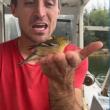Lobsterman Sees Birds Falling from Sky
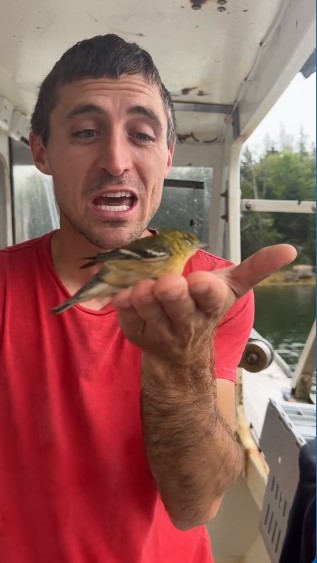 Lobsterman who witnessed birds seemingly falling from the sky, a scene shared on a TikTok video.
Lobsterman who witnessed birds seemingly falling from the sky, a scene shared on a TikTok video.
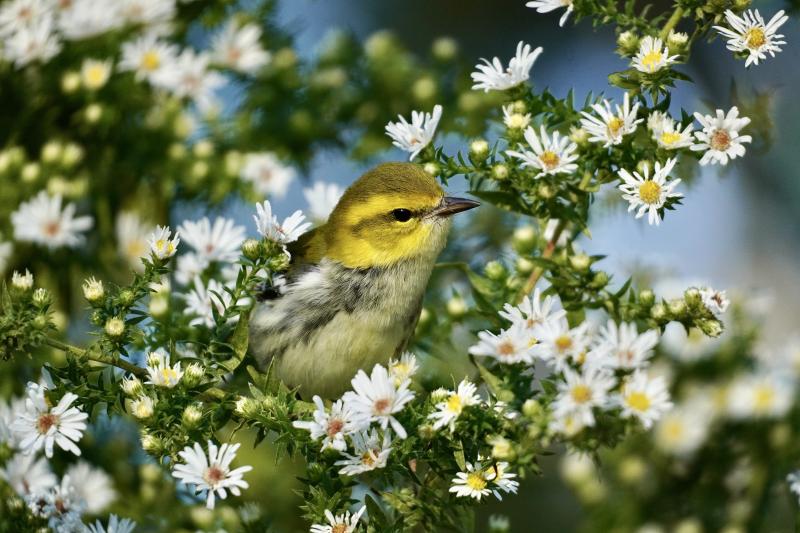 Black-throated green warblers were among the birds rescued by lobsterman off the Maine coast last week. Photo by Fetafete, courtesy of Wikimedia Commons
Black-throated green warblers were among the birds rescued by lobsterman off the Maine coast last week. Photo by Fetafete, courtesy of Wikimedia Commons
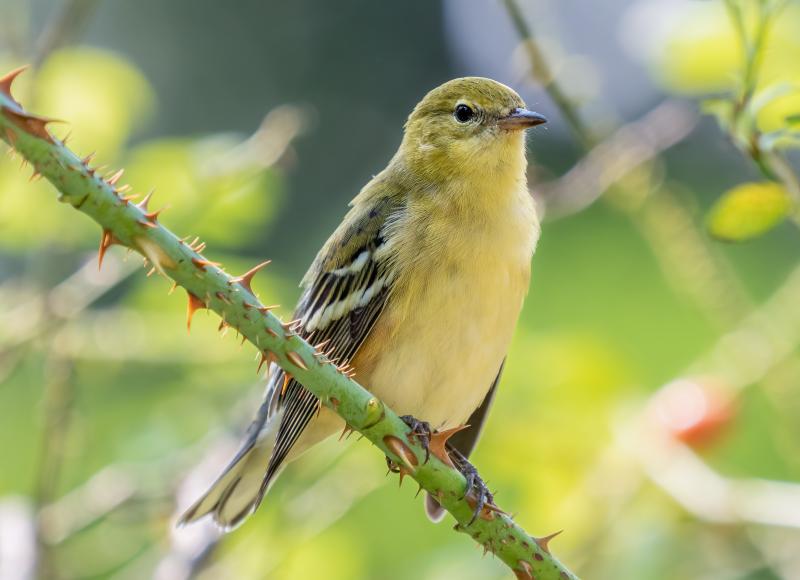 Bay-breasted warblers make the long journey from Canada and the northeastern U.S. where they breed to Central America for the winter, many passing through Maine. No wonder they were caught on the lobsterman’s video! Photo by Rhododendrons, courtesy of Wikimedia Commons.
Bay-breasted warblers make the long journey from Canada and the northeastern U.S. where they breed to Central America for the winter, many passing through Maine. No wonder they were caught on the lobsterman’s video! Photo by Rhododendrons, courtesy of Wikimedia Commons.
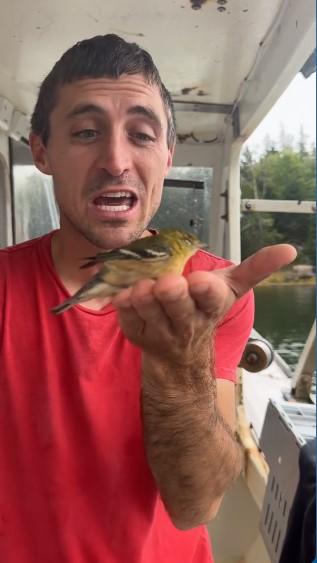 Lobsterman who witnessed birds seemingly falling from the sky, a scene shared on a TikTok video.
Lobsterman who witnessed birds seemingly falling from the sky, a scene shared on a TikTok video.
 Black-throated green warblers were among the birds rescued by lobsterman off the Maine coast last week. Photo by Fetafete, courtesy of Wikimedia Commons
Black-throated green warblers were among the birds rescued by lobsterman off the Maine coast last week. Photo by Fetafete, courtesy of Wikimedia Commons
 Bay-breasted warblers make the long journey from Canada and the northeastern U.S. where they breed to Central America for the winter, many passing through Maine. No wonder they were caught on the lobsterman’s video! Photo by Rhododendrons, courtesy of Wikimedia Commons.
Bay-breasted warblers make the long journey from Canada and the northeastern U.S. where they breed to Central America for the winter, many passing through Maine. No wonder they were caught on the lobsterman’s video! Photo by Rhododendrons, courtesy of Wikimedia Commons.
A reader sent us a link to an interesting TikTok video a few days before Hurricane Lee was expected to hit. In the video, a young Maine lobsterman in a red T-shirt and blue jeans standing at the wheel of his boat, describes the massive numbers of small migrating land birds that he and his crew were seeing offshore. Some were trying to land on the boat; others, in the water. At the start of the video, the lobsterman has what looks like a bay-breasted warbler sitting, exhausted, on his head as he speaks. Later we see small birds flying around the boat and five or six that they have been able to secure under some netting to bring to shore. We could identify the bright yellow faces of several black-throated green warblers and the gray cap and yellow breast of a Philadelphia vireo.
Another segment in the same TikTok shows hundreds of birds swirling around the lights of a boat.
The lobsterman speaking in the video expresses concern that these large numbers of birds may be an omen of how bad the impending hurricane might turn out to be. At the end of the video, with the boat moored in a classic Maine harbor dotted with other lobsterboats, a tiny and colorful northern parula warbler, gleaming yellow and blue, lands on the head of his bemused and bearded sternman.
What was happening?
Many people don’t realize that most birds migrate at night. At the height of fall migration in the U.S., that means that under favorable migration conditions, there are hundreds of millions of birds passing overhead as we sleep. When dawn breaks, these migrating birds drop down into the landscape below them to eat, drink, and rest until the next night when, if in good condition, they can continue their nocturnal migration journey.
Birds flying near the coast may drift out over the ocean during the night. As dawn breaks, many of them will be looking for a place to land for the day. Places like Monhegan Island are a magnet for birds in these circumstances, drawing in as they search for a safe place to rest. Boats can become refuges for birds when no land is in sight. A few years ago, on a trip out to Monhegan, we had several magnolia warblers circle repeatedly around the boat, one landing briefly on the head of a surprised passenger.
What’s different in this TikTok video is the large number of birds involved. This probably has several explanations. In order to have large quantities of birds passing through an area at night, there usually has to be clear skies and often light, northerly winds to the North. That causes a high number of birds to be aloft and migrating at night. When a large volume of night-migrating birds runs into rainy and/or foggy conditions while still flying, they seek a place to land. Suddenly they find themselves in a disorienting swirl where it is hard for them to distinguish the ground, trees, buildings, land, or water. At night in this situation, birds often are drawn to lights and will sometimes continue to swirl around and around them in their confusion.
Lighthouse keepers along the Maine coast often reported finding lots of dead birds under such conditions around the light. We ourselves have witnessed birds following the light of a lighthouse around and around at night, seemingly caught in the beam.
The events shown in these videos probably are the result of migrating birds being caught in these kinds of conditions. This would not have been as a result of the hurricane, although the eventual northward path of the hurricane was related to the same weather conditions that impacted the southward paths of those migrating birds. And hurricanes do have major impacts to migrating birds, sometimes likely killing large numbers under certain conditions. Other times they may just cause birds to change their path or to hunker down and wait things out. Some larger birds, like certain shorebirds, may be able to take advantage of the stronger northerly winds on the western edge of a hurricane to get south even faster than normal.
Sometimes hurricanes suck up oceanic birds from farther south and essentially spit them out farther north or even over land when the storm weakens. Birders love to look for these way-out—of-range species that they would normally never get to see where they live. As of yet, we haven’t heard of any such oddities from Hurricane Lee here in Maine, but you can be sure birders were looking and will probably continue checking for anything odd that might appear over the next week or so.
Jeffrey V. Wells, Ph.D., is a Fellow of the Cornell Lab of Ornithology and Vice President of Boreal Conservation for National Audubon. Dr. Wells is one of the nation's leading bird experts and conservation biologists. He is a coauthor of the seminal “Birds of Maine” book and author of the “Birder’s Conservation Handbook.” His grandfather, the late John Chase, was a columnist for the Boothbay Register for many years. Allison Childs Wells, formerly of the Cornell Lab of Ornithology, is Senior Director of Communications at the Natural Resources Council of Maine, a nonprofit membership organization working statewide to protect the nature of Maine. Both are widely published natural history writers and are the authors of the popular books, “Maine’s Favorite Birds” (Tilbury House) and “Birds of Aruba, Bonaire, and Curaçao: A Site and Field Guide,” (Cornell University Press).




